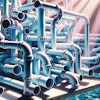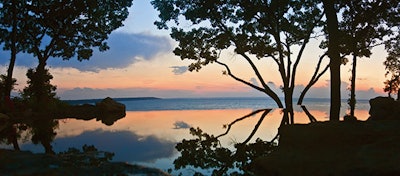

Bill Renter of the Deck and Patio Company, a landscape design and construction firm based in Huntington Station, N.Y., is passionate about bodies of water that look natural. A student of nature, as well as the fine points of both swimming pools and man-made ponds, his work offers multiple examples of pools built to look natural and ponds made with swimming in mind. Despite the fact that the pond and pool industries are widely perceived as completely separate, his firm’s body of work stands as an example of what can be achieved when working to master both.
As is true of many in this profession, I have a profound appreciation for the impact water can have when expertly designed into the landscape — whether the water fills a pool or a pond. But while most pool builders only specialize in pools and pond builders just ponds, our firm, the Deck and Patio Company, pursues parallel tracks in creating both ponds and pools. By doing both, we’ve carved out a niche for ponds that accommodate swimming, and likewise, pools that aesthetically have a lot in common with ponds.
For both pools and ponds, it’s really all about the aesthetics and how the clients intend to use the water. During the design phase, we go to great lengths to educate the homeowner about the differences between pools and ponds and the options available for both.
Traditionally, ponds are considered purely aesthetic while pools, of course, are both aesthetic and built for immersion. In practice, we’ve found the lines are far more blurred. These days, a great many of our pond projects are designed with swimming in mind. Likewise, a large number of our swimming pools are designed with distinctly naturalistic aesthetics.
The biggest difference is how the water is treated. Most pools employ the “kill the water” approach where powerful sanitizers and oxidizers render the water nearly lifeless. Ponds typically employ the gentler approach of creating a balanced eco-system where the natural processes of biological filtration and nutrient uptake from plants create bodies of water that are both teeming with life and are also safe for human contact.
These days, even that distinction is being obscured by pools that use biological treatment. I’m reasonably certain those types of installations will someday become part of our work, as well.
I’ve found it interesting that many clients are interested in getting away from chlorine, while others are uncomfortable with the idea of swimming in water that contains life because they see it as “dirty.” For the former, we point out that if managed properly, traditional swimming pool treatment produces no ill effects. For the latter we point out that people swim in lakes, rivers and oceans without any problems and that our ponds are perfectly suitable for human immersion.
It’s really a matter of preference, and whichever way our clients decide to go, we’re going to deliver systems that are both beautiful and healthy.
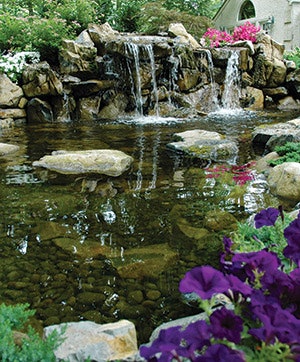
In terms of aesthetics, that’s where we really have fun. On the swimming pool side of the equation, probably 80 to 90 percent of our designs have a natural look. Our portfolio is full of projects that feature sweeping multi-radii contours and deep finish colors that enhance the reflective qualities of the water. And we often use large quantities of natural stone to create appealing edge treatments as well as waterfalls and streams that visually fuse the pool structure with the surrounding landscape.
Our work in ponds has taught us a number of details that increase the sense of realism. For example, we avoid creating structures that look like someone came and piled up a bunch of small rocks on one end of the pool. Instead we lean toward using a few larger rocks that appear as though they’re part of a large subsurface formation that has been exposed by the natural processes of wind and erosion, just as you’d typically find in nature. Another way to look at it is that a large body of water pushed the rocks together and the only way for the water to continue downhill is to flow over the rocks.
Point being, in nature you don’t see a bunch of rocks stacked up that look like cannonballs, but instead larger pieces that create a natural vertical transition.
We also avoid the “string of pearls” effect where you have a series of stones of roughly the same size encircling the water. We’ll often notch large stone pieces so that they hug the edge with part of the stone submerged. We also distribute stone material used in the edges or waterfalls back away from the water’s edge to create visual integration with the landscape. And we often create strategic planting pockets amongst the stones so that they are draped in greenery that touches the water.
EDGES, ENTRY AND EGRESS

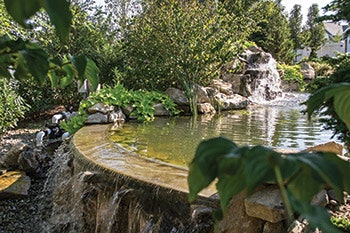
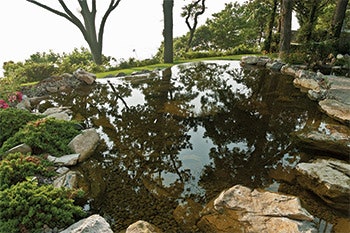
Building a pond for swimming really isn’t all that much of a creative stretch, so long as you keep the human element in mind. In particular, that means making it easy to get in and out of the water. That’s why we include large, flat boulders along the edges and use rock material (or concrete, in some cases) to create “steps” down into the water.
Even if you don’t go in the water, per se, the flat surfaces make it easy to come right to the water’s edge where you can easily see and even touch the fish or peer beneath the surface and see the rock material at the pond’s bottom. Many of our projects also include beach entries, which create wonderful places to interact with the water and enjoy lounging next to it.
Also, ponds built for immersion need to be deep enough for wading, at the very least and large enough so that someone can swim a few strokes or more. It’s all really a matter of common sense and, again, having a crystal clear understanding of how the client plans on using the space. That said, even for ponds that are intended to be purely decorative, we always have in mind that kids will find their way into the water, so it’s really never a bad idea to set up the edges with the idea that at some point, someone may likely take a dip.
Another area where our work with pools has influenced pond designs involves the vanishing edge. Lew Akins’ classes on building vanishing edges have inspired me — so much so that when I first saw some of his designs, I thought to myself, “Someday I’m going to build a pond with a vanishing edge.” More than a decade later, we’ve done two so far.
We pay attention to all the aesthetic issues that we learned from Aquascape, all those details that give the body of water its realistic appearance, but the hydraulics are done like a pool. Specifically, we use variable speed drive pumps so we can adjust the flow over the edge to where we’re wetting the edge with the minimum amount of water possible. That differs from the traditional pond set up, where the pump is located in the bottom of the skimmer. We also feel that having the pump outside the body of water adds a measure of electrical safety.
Like vanishing edge pools, these pond systems are designed with surge capacity in mind. In addition to the properly sized catch basin, we use the Aquascape, Aqua-blox as storage tanks, which serve the dual purpose of containing rainwater-harvesting run off and accommodating any sudden bather surge.
As is true of vanishing edge pools, the edge wall is critical. For both vanishing-edge pond projects we poured a concrete wall to create the weir. Then we lined it with a layer of foam, just as you would in a vinyl-liner pool, on top of that we added underlayment to add strength and protect the liner from abrasion damage.
On top of that, the edge itself is made with blue stone we cut to match the shape of the wall. The edge is leveled with a water-level to a tolerance of 1⁄8 th inch, which ultimately means we can use the variable speed drive pump to fine tune the flow over the edge.
THE VALUE OF INFLUENCE
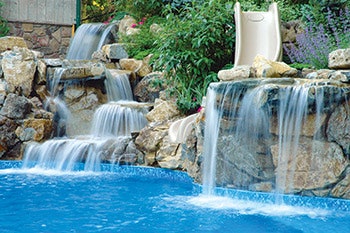
Both the pond and pool building disciplines are so vast that I’m certain we’ll never be done learning new techniques and design perspectives. In our case, we’ve found that by crossing over between ponds and pools, both disciplines enhance the other.
It’s somewhat surprising that both industries are perceived as being completely separate. That disconnect is ironic because in both fields, we’re using water to add beauty, drama and function to the landscape. For us, working with ponds and pools feels natural and it gives us a broader range of ways to satisfy our clients than if we stuck with just one or the other.
To my mind, both ponds and pools have much more in common than most people have dared to imagine. I like to think our work is living proof of the power found when you do both.
Comments or thoughts on this article? Please e-mail [email protected].


















